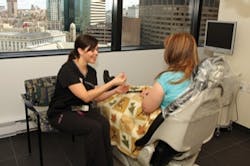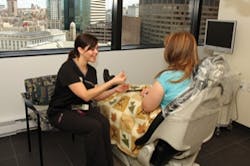Simplifying the adhesive process
by Stephen Poss, DDS
For more on this topic, go to www.dentaleconomics.com and search using the following key words: adhesive process, self-etch adhesive, total-etch system, amalgam, Dr. Stephen Poss.
As practicing clinicians, we are inundated with new dental products on a regular basis. One of the cornerstones for any practicing clinician is adhesive dentistry. Although there are many excellent dental adhesives on the market, there is a considerable amount of confusion about when to utilize a self-etching adhesive versus a total-etch system.
This is especially true when seating an all-ceramic crown made of zirconia or lithium disilicate. The clinician has the option of using self-etching cement or a total-etch technique with a light-cure cement; however, if the clinician is placing porcelain veneers, then a total-etch technique is recommended. This has led to a great deal of confusion in what adhesive to use and whether it's appropriate for a given indication.
Wouldn't it be more economical - and more efficient - to have just one system that covers all adhesive concerns?
Kerr Corporation, with its strong adhesive history with the OptiBond family of products, has recently introduced OptiBond XTR. This is a sixth generation system that can meet all your adhesive needs without phosphoric acid. This is a two-component, universal, self-etch adhesive system.
How is this possible? The OptiBond XTR primer has a ternary solvent system. The first is water, which provides a medium for the acid monomer to manifest its acidity and enhances the etching/wetting ability of the primer.
The second is acetone, which is quickly evaporated during application, resulting in a decrease in the pH of the primer for enhanced etching.
The third is ethyl alcohol, which enhances the wetting of the primer. So what does all of this actually mean? OptiBond XTR can provide a strong self-etching adhesive system to uncut enamel and other dental substrates.
In several independent studies, the shear bond strengths to uncut enamel are in the 30s (MPa). With cut enamel, bond strengths are about 40 MPa, and with dentin, they are in the mid-40s (MPa).
The adhesive portion of OptiBond XTR has 0.4-micron barium glass filler. It is 15% filled, containing a fluoride-releasing agent and nanofillers. OptiBond XTR is also beneficial if the clinician is seating a laboratory restoration because it has a low film thickness of approximately 5 microns.
Additionally, it is compatible with all self- and dual-curing resin cements and core materials. Low-film thickness and material compatibility make OptiBond XTR a universal adhesive because it can be used with both direct restorations and indirect laboratory restorations.
Clinical Case I
A 40-year-old female had two failing amalgam restorations on teeth numbers 18 and 19. The amalgams were removed. The OptiBond XTR Primer was placed on all prepared areas for 20 seconds and air-dried to evaporate the solvent.
The OptiBond XTR adhesive was applied for 15 seconds and air-dried. The adhesive was light-cured for 10 seconds. While all composites are compatible with OptiBond XTR, Herculite Ultra was placed. The occlusion was checked and the restoration polished.
Clinical Case II
This 70-year-old lady was in need of several crown and veneer restorations due to the failure of composite restorations on teeth 5-12. OptiBond XTR can be used with any porcelain. In this particular case, E-Max (lithium disilicate) was used for all the anterior crowns and veneers. Before the porcelain was seated, the restorations were thoroughly cleaned. That included sandblasting with aluminum oxide. Each restoration was then etched with hydrofluoric acid.
Once the hydrofluoric acid was rinsed off, a coat of Kerr's Silane Primer was placed in each restoration and allowed to air dry. Once the provisionals were removed, the teeth were cleaned, isolated, and dried. A coat of the OptiBond XTR primer was placed on each tooth for 20 seconds and then air-dried.
A coat of the OptiBond XTR adhesive was then placed on each tooth for 15 seconds. The solvent evaporated off, and each tooth was light-cured for 10 seconds.
Any light-cured, dual-cured, or self-cured cements can be used since OptiBond XTR is compatible with all dental materials. This clinician chose to use Kerr's NX3 Nexus Third Generation light cure resin cement.
Curing all surfaces for 20 seconds is recommended once the restoration is seated.
OptiBond XTR offers the clinician the best of both worlds. The dentist can use one adhesive system for both direct and indirect restorations, and use it with the confidence that it will provide a strong bond to both cut and uncut enamel, without postoperative sensitivity concerns.
This can save time and expense. In this economy, that's always a win-win for both the clinician and the patient.
Dr. Stephen Poss is the clinical director at the Center for Exceptional Practices in Cleveland, Ohio. He has directed numerous live patient continuums at various teaching institutes since 1995, emphasizing anterior and posterior esthetic dentistry. Dr. Poss lectures nationally and internationally on esthetic dentistry and TMD. He maintains a cosmetic-oriented restorative practice in Brentwood, Tenn. Contact him by e-mail at [email protected].



